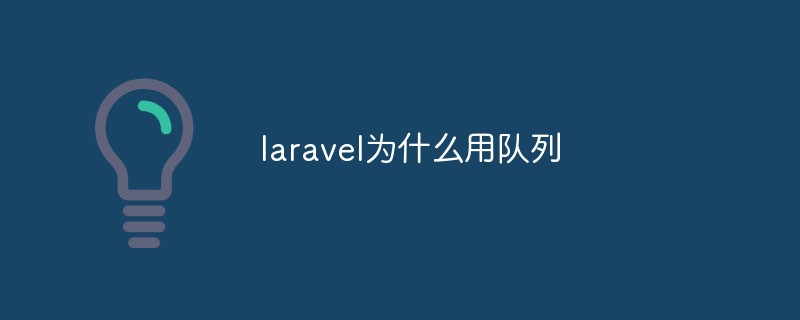Home >PHP Framework >Laravel >Why laravel uses queue
Why laravel uses queue
- WBOYWBOYWBOYWBOYWBOYWBOYWBOYWBOYWBOYWBOYWBOYWBOYWBOriginal
- 2022-03-14 16:45:242898browse
In laravel, using queues can solve problems such as large concurrency and multi-language communication interfaces. Time-consuming tasks or tasks that cannot be parallelized in large numbers at the same time can be encapsulated and transferred to the message queue. The handler will continuously extract messages from the message queue and process them. In this way, using the message queue can eliminate the need for large-scale concurrency. clogged.

#The operating environment of this article: Windows 10 system, Laravel version 6, Dell G3 computer.
Why laravel uses queues
Message queue is an essential module for large-scale Web projects. Through message queue, problems such as large concurrency and multi-language communication interfaces can be solved.
For large concurrency problems, time-consuming tasks or tasks that cannot be parallelized in large numbers at the same time can be encapsulated and transferred to the message queue. The handler will continuously extract messages from the message queue and process them. In this way, through the message The buffering of the queue can prevent blocking in large concurrency situations. If the performance is not enough, multiple processing tasks can be added to obtain messages from the message queue for processing.
For example, in database operations, when there are too many read and write operations on the database, there will be problems such as locking tables. The read problem can be solved through caching and other solutions, while the write problem needs to be solved by message queues.
Moreover, in the development of large-scale Web projects, in many cases it is impossible to implement it through one language. It is necessary to take advantage of different languages, such as PHP, although in a theoretical sense it can do everything in Web development. thing, but the efficiency of using it to solve some problems will be very low, such as real-time socket connection and distributed transaction processing.
Use Laravel's message queue to process asynchronous tasks, Redis as the queue database, Supervisor monitoring script abnormal interruption and automatic restart, this is Laravel's standard process for processing queue tasks, but in practice there may be various In order to ensure the reliability of the system, several issues need to be paid attention to.
1. Setting the number of retries for failed execution
Be sure to set the number of retries for failed task execution to avoid infinite failed retries. If the number of retries is exceeded, Laravel will write by default In the failed task table, you can also write your own execution failure follow-up processing logic.
php artisan queue:work redis --tries=3
You need to execute the following command first to create a data table:
php artisan queue:failed-table
php artisan migrate
2. Handling program exceptions
Sometimes exceptions may occur during program execution, such as relying on other interfaces, requesting the HTTP interface timeout, etc. If If exceptions are not caught, the current queue will be interrupted and cannot continue to run. For example, pushing content to 10,000 users requires relying on interface push. If the intermediate request hangs, subsequent pushes will be affected.
The exception here refers to an exception that occurs during program execution. It does not mean that the resident process hangs up. Program exceptions do not necessarily cause the resident process to be interrupted. Moreover, process interruptions are monitored and restarted by the Supervisor.
Such as catching exception code snippets:
try {undefined
$r = $client->request('POST', '', [
'query' => [
'client_name' => 'filemail',
'client_version' => '1.0',
'client_sequence' => 0,
'uid' => 692934013,//119481237
'r' => 1508312484,
],
'body' => \GuzzleHttp\json_encode($body),
]);
$result = $r->getBody()->getContents();
$result = json_decode($result, true);
if ($result['result'] == 0) {undefined
info("sendMail fail:" . json_encode($result));
$this->pushLog($task['id'], $task['mail_id'], implode(',', $userIds), json_encode($result), 0);
} else {undefined
Log::warning("sendMail fail:" . json_encode($result));
$this->pushLog($task['id'], $task['mail_id'], implode(',', $userIds), json_encode($result), $result['result']);
}
} catch (RequestException $e) {undefined
Log::warning('RequestException' . $e->getMessage());
} catch (Exception $e) {undefined
Log::emergency('Exception' . $e->getMessage());
}[Related recommendations: laravel video tutorial]
The above is the detailed content of Why laravel uses queue. For more information, please follow other related articles on the PHP Chinese website!

